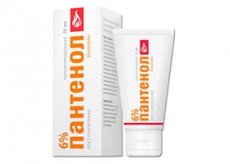Medical expert of the article
New publications
Preparations
Panthenol
Last reviewed: 03.07.2025

All iLive content is medically reviewed or fact checked to ensure as much factual accuracy as possible.
We have strict sourcing guidelines and only link to reputable media sites, academic research institutions and, whenever possible, medically peer reviewed studies. Note that the numbers in parentheses ([1], [2], etc.) are clickable links to these studies.
If you feel that any of our content is inaccurate, out-of-date, or otherwise questionable, please select it and press Ctrl + Enter.

Indications Panthenol
The ointment is indicated in the following cases:
- to accelerate epithelialization and the healing process of skin areas that have been subjected to microdamage (for example, small abrasions and mild burns), and in addition to this, to treat skin irritations (arising from ultraviolet radiation or after photo- and radiotherapy procedures), bedsores and skin ulcers (chronic form). It is also used to eliminate anal fissures, cervical erosions and after skin transplantation;
- for treatment or as a preventative measure for treating dry, rough or cracked skin;
- continuous prevention of breast diseases in nursing mothers, and also to eliminate cracks and irritations in the nipple area;
- when treating infants – eliminating diaper dermatitis or preventing this pathology;
- treatment of the skin of persons who use corticosteroids locally (or after completion of such a course of treatment).
Release form
It is produced in the form of an ointment, in a 30 g tube. Each separate pack contains 1 tube of ointment.
Panthenol aerosol
Panthenol aerosol should be used to eliminate various damages to mucous membranes and skin (including burns and abrasions), as well as aseptic wounds left after surgical operations and dermatitis (vesicular and bullous forms). In addition, it is used for skin transplants.
Panthenol capsules 40 mg
Panthenol capsules are used to treat alopecia, splitting and brittle hair, and to eliminate excessive dandruff. Along with this, the medicine is used for problems with hair growth, increased secretion of the sebaceous glands, urticaria with eczema, rashes and dermatoses (complicated by itching). Also, capsules should be taken for allergic rhinitis, inflammation of the gums and hyperhidrosis of the extremities.
The medicine should be taken after meals. The capsules are swallowed whole with water.
For adolescents aged 15 and over and adults, the dose is 2 capsules three times a day. Children aged 3-6 years – 1 capsule once a day. Children aged 6-12 years – 1 capsule twice a day. Children aged 12-15 years – 1 capsule three times a day.
The duration of the therapeutic course is 1-3 months.
Pharmacodynamics
The active component of the drug is dexpanthenol, which is quickly converted into pantothenate inside the cells, after which it begins to act on the body as a vitamin. The absorption of dexpanthenol after local application occurs faster than a similar process of pantothenate.
Pantothenic acid is one of the components of coenzyme type A (CoA). This component, acquiring the form of acetyl coenzyme type A, becomes the main participant in the processes of cellular metabolism. That is why pantothenate is a necessary element in the processes of healing and restoration of injured mucous membranes and skin.
Pharmacokinetics
Dexpanthenol is absorbed into the body quite quickly through the skin, after which it is converted into pantothenate and included in the internal vitamin depot.
The transformed substance is synthesized with plasma protein (mainly albumins together with β-globulins). Pantothenic acid levels in healthy people are approximately 500-1000 μg/l in the blood, and 100 μg/l in the blood serum.
Pantothenate is not metabolized and is excreted unchanged from the body. Urinary excretion in adults is 2-7 mg per day, and in children - 2-3 mg.
Dosing and administration
When eliminating superficial wound injuries of any nature, as well as for prophylactic treatment of dry/rough or cracked skin, the ointment should be used once a day. But if necessary, it is allowed to increase the frequency of application procedures.
When treating the mammary glands of nursing mothers, the nipple areas should be treated after each feeding procedure.
To eliminate defects that have formed on the mucous membrane of the cervix, it is necessary to use the ointment once or several times a day (under the supervision of the attending physician).
When treating infants, Panthenol ointment should be applied with each diaper change.
Use Panthenol during pregnancy
According to existing information, the use of Panthenol does not pose any risk to pregnant or lactating women. However, during pregnancy, it is recommended to use the drug only as prescribed by a doctor.
When treating cracked nipples during lactation, it is necessary to wash off the medicine before the feeding procedure.
Contraindications
Contraindication is hypersensitivity to dexpanthenol or other components of the drug.
Side effects Panthenol
The use of the ointment may cause the development of side effects on the skin and subcutaneous layer, as well as on the part of the immune system: manifestations of allergies in the form of dermatitis (allergic or contact form), rashes, itching, urticaria and eczema, as well as skin irritation, erythema and the appearance of blisters.
Storage conditions
The medicine should be kept out of the reach of small children. The temperature should not exceed 25°C.
 [ 6 ]
[ 6 ]
Shelf life
Panthenol in the form of an ointment can be used for a period of 5 years, and in the form of a spray and capsules - for 3 years from the date of release of the drug.
Attention!
To simplify the perception of information, this instruction for use of the drug "Panthenol" translated and presented in a special form on the basis of the official instructions for medical use of the drug. Before use read the annotation that came directly to medicines.
Description provided for informational purposes and is not a guide to self-healing. The need for this drug, the purpose of the treatment regimen, methods and dose of the drug is determined solely by the attending physician. Self-medication is dangerous for your health.

